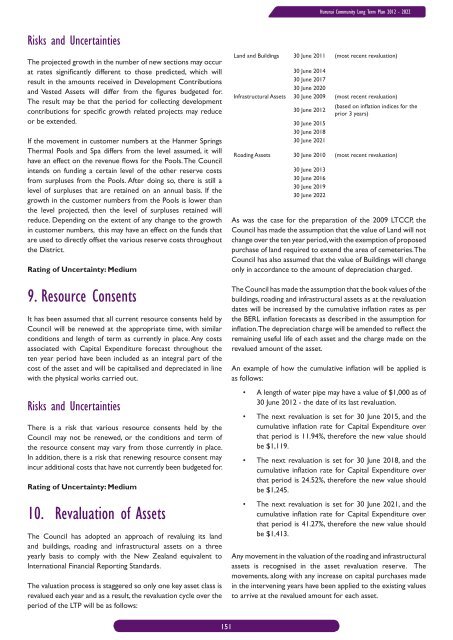Long Term Community Plan 2012-2022 - Hurunui District Council
Long Term Community Plan 2012-2022 - Hurunui District Council
Long Term Community Plan 2012-2022 - Hurunui District Council
You also want an ePaper? Increase the reach of your titles
YUMPU automatically turns print PDFs into web optimized ePapers that Google loves.
<strong>Hurunui</strong> <strong>Community</strong> <strong>Long</strong> <strong>Term</strong> <strong>Plan</strong> <strong>2012</strong> - <strong>2022</strong><br />
Risks and Uncertainties<br />
The projected growth in the number of new sections may occur<br />
at rates significantly different to those predicted, which will<br />
result in the amounts received in Development Contributions<br />
and Vested Assets will differ from the figures budgeted for.<br />
The result may be that the period for collecting development<br />
contributions for specific growth related projects may reduce<br />
or be extended.<br />
If the movement in customer numbers at the Hanmer Springs<br />
Thermal Pools and Spa differs from the level assumed, it will<br />
have an effect on the revenue flows for the Pools. The <strong>Council</strong><br />
intends on funding a certain level of the other reserve costs<br />
from surpluses from the Pools. After doing so, there is still a<br />
level of surpluses that are retained on an annual basis. If the<br />
growth in the customer numbers from the Pools is lower than<br />
the level projected, then the level of surpluses retained will<br />
reduce. Depending on the extent of any change to the growth<br />
in customer numbers, this may have an effect on the funds that<br />
are used to directly offset the various reserve costs throughout<br />
the <strong>District</strong>.<br />
Rating of Uncertainty: Medium<br />
9. Resource Consents<br />
It has been assumed that all current resource consents held by<br />
<strong>Council</strong> will be renewed at the appropriate time, with similar<br />
conditions and length of term as currently in place. Any costs<br />
associated with Capital Expenditure forecast throughout the<br />
ten year period have been included as an integral part of the<br />
cost of the asset and will be capitalised and depreciated in line<br />
with the physical works carried out.<br />
Risks and Uncertainties<br />
There is a risk that various resource consents held by the<br />
<strong>Council</strong> may not be renewed, or the conditions and term of<br />
the resource consent may vary from those currently in place.<br />
In addition, there is a risk that renewing resource consent may<br />
incur additional costs that have not currently been budgeted for.<br />
Rating of Uncertainty: Medium<br />
10. Revaluation of Assets<br />
The <strong>Council</strong> has adopted an approach of revaluing its land<br />
and buildings, roading and infrastructural assets on a three<br />
yearly basis to comply with the New Zealand equivalent to<br />
International Financial Reporting Standards.<br />
The valuation process is staggered so only one key asset class is<br />
revalued each year and as a result, the revaluation cycle over the<br />
period of the LTP will be as follows:<br />
Land and Buildings 30 June 2011 (most recent revaluation)<br />
30 June 2014<br />
30 June 2017<br />
30 June 2020<br />
Infrastructural Assets 30 June 2009 (most recent revaluation)<br />
30 June <strong>2012</strong><br />
(based on inflation indices for the<br />
prior 3 years)<br />
30 June 2015<br />
30 June 2018<br />
30 June 2021<br />
Roading Assets 30 June 2010 (most recent revaluation)<br />
30 June 2013<br />
30 June 2016<br />
30 June 2019<br />
30 June <strong>2022</strong><br />
As was the case for the preparation of the 2009 LTCCP, the<br />
<strong>Council</strong> has made the assumption that the value of Land will not<br />
change over the ten year period, with the exemption of proposed<br />
purchase of land required to extend the area of cemeteries. The<br />
<strong>Council</strong> has also assumed that the value of Buildings will change<br />
only in accordance to the amount of depreciation charged.<br />
The <strong>Council</strong> has made the assumption that the book values of the<br />
buildings, roading and infrastructural assets as at the revaluation<br />
dates will be increased by the cumulative inflation rates as per<br />
the BERL inflation forecasts as described in the assumption for<br />
inflation. The depreciation charge will be amended to reflect the<br />
remaining useful life of each asset and the charge made on the<br />
revalued amount of the asset.<br />
An example of how the cumulative inflation will be applied is<br />
as follows:<br />
• A length of water pipe may have a value of $1,000 as of<br />
30 June <strong>2012</strong> - the date of its last revaluation.<br />
• The next revaluation is set for 30 June 2015, and the<br />
cumulative inflation rate for Capital Expenditure over<br />
that period is 11.94%, therefore the new value should<br />
be $1,119.<br />
• The next revaluation is set for 30 June 2018, and the<br />
cumulative inflation rate for Capital Expenditure over<br />
that period is 24.52%, therefore the new value should<br />
be $1,245.<br />
• The next revaluation is set for 30 June 2021, and the<br />
cumulative inflation rate for Capital Expenditure over<br />
that period is 41.27%, therefore the new value should<br />
be $1,413.<br />
Any movement in the valuation of the roading and infrastructural<br />
assets is recognised in the asset revaluation reserve. The<br />
movements, along with any increase on capital purchases made<br />
in the intervening years have been applied to the existing values<br />
to arrive at the revalued amount for each asset.<br />
151

















